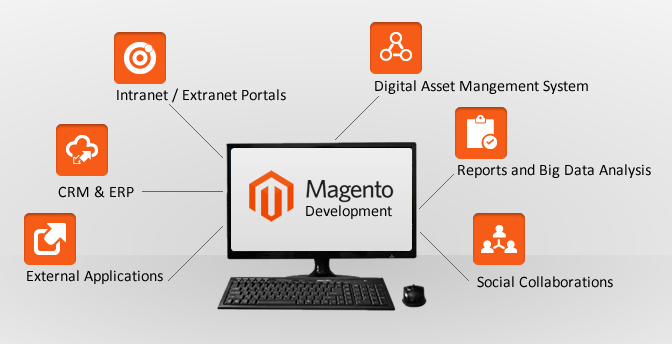
When you are going to create your own website or an online store, there are two basic ways to make this happen. First, you might boost your in-house development team, or outsource development to another team or a professional. In both cases, there is a need to hire professionals who are going to develop the project for you. Certainly, hiring highly qualified experts is going to help your project shine, therefore there is a need to choose the right people for the job. While there are many factors to consider, this article is going to discuss the questions to ask a developer when on the interview (you will probably have one).
Interview Questions with Responses for Magento Developers
Mixed Interview Questions
Question 1. Could you please name the methods of altering the way that Magento works, focusing on potential ways to expand Magento core features? Please, comment on the differences and peculiarities of these methods.
Answer: Basically, there are three methods to modify the way Magento works by overriding core functionalities. These three ways are performing money patches, doing rewrites, and using observers. To start with, the least favored method is the use of monkey patches. The idea of monkey patches is based on overriding the modules that are positioned in the core. To do this, community code pools are usually used. In other words, community codes are simply copied into the local code. Therefore, the method of Rewrites is easier and quicker than the monkey patches.
Second, the Rewrites method is used to rewrite a function by determining a class that is described in your config file. The Rewrites method work by rewriting an existing class, which is less effortful than the use of monkey patches because only one function is rewritten. However, the method Observers is the most useful because it implies the action when certain functions are performed. Using the Observers method, it is easier to alter the event that is launched already.
Question 2. Could you please name the best way to count the items in a collection
Answer: When we want to count the items in a collection, we apply the method getSize() because, with this method, all items of the collection are not stacked every time when they are counted but loaded only once. GetSize() is better because it loads items only once while the Count() method loads items every time when counting. As a result, getSize() allows minimizing the memory usage by loading and counting the items in the collection only once.
Question 3. Could you please comment on the EAV naming its pros and cons?
Answer. To begin with, EAV is the abbreviation for entity-attribute-value. It is the approach that describes the way that customers, products, and address data are stored in a Magento database. The use of EAV implies that the information is retrieved with a query that consists of three tables of customers, products, and addresses. Often, this enables a user to change the attributes easily with no need to modify the database schema, which means having a flexible database. However, the process is resource-consuming and practically, it minimizes the advantages of the use of the relational database. Moreover, with the EAV, even the most basic queries are going to be challenging to write, which minimizes the benefits of the EAV use.
Question 4. Could you please describe how to change the CSS of your theme in Magento?
Answer. Basically, to change CSS of your current team, you need to create a new Magento theme, which is relatively easy to do. Practically, you are supposed to edit the file local.xml. This file is located in the layout folder of the current Magento theme. Thus, with Magento, a new theme can be easily created by changing template files. This makes the theme easily reusable and allows to save the new themes. In other words, there is a need to override current styles.css with saving it as an individual customized design.
Question 5. Could you please define deploy modes in Magento 2?
Answer. In Magento 2, there are three major modes, namely developer, default, and production. The Default mode is installed by default, and others need to be switched on to be used. For example, the Developer mode is used when programming errors need to be caught in the front end. Therefore, in the Developer mode, static view file caching is disabled, and enhanced debugging is enabled instead. As a result, all caught exceptions and errors are displayed in the front end and the developers might see the errors in real-time. Just to compare, in the Default mode, caching works as supposed, and exceptions are not displayed to the user but are written to the log file instead. In the Production mode, necessary files are generated and placed in the pub/static folder, which is a must for all Magento 2 websites working in production because this mode prevents automatic file compilation. One more mode that is rarely used is the Maintenance mode that is used only when there is a need to prevent access to the website during maintenance or upgrading.
Question 6. Could you please describe and comment on a factory class in Magento 2?
Answer. Factory class is a service class that is used for non-injectables. Developers use factory classes to create, get or change records without direct use of ObjectManager. For models that represent database entities, factory classes are created automatically and the factory class is used to instantiate an object.

Basic Interview Questions
Question 7. Could you please name the scripting language and the database that is used for Magento 2?
Answer: Magento 2 is based on PHP 5.4., 5.5., and above for scripting and on MySQL 5.6 for the database architecture.
Question 8. Could you please comment on the process of module creation in Magento?
Answer: A module creation in Magento is simple and consists of three basic steps. First, we name the module and define it in the app/code folder. Second, we create a new file and give it a name registration.php. Third, we enable the module inside the folder.
Question 9. Could you please comment on Magento dependency injections?
Answer: Dependency injection is a design pattern in Magento 2 that is aimed to implement control inversion. The principal gains of using Magento dependency injections comprise code reusability,easier-to-test code, and improved hassle-free app maintenance.
Question 10. Could you please compare the benefits of Magento 2 and Magento 1?
Answer: Magento 2 is definitely better to use than the first version of Magento compared to Magento 1, including the next improved features:
- Scalable architecture
- Core built on the latest versions of PHP, Zend, Symphony, Apache, and Nginx.
- Integration support for PWA which is getting more popular today
- a built-in page builder.
- Advanced performance
- Enhanced speed
- Intuitive backend UI
- Easy-to-use admin panel, even in the mobile version
Question 11. Could you please discuss the static blocks in Magento 2?
Answer: Static blocks are the parts of content that are similar for all pages of your Magento 2 store. They are often used to display information that is never changing. Thus, static blocks facilitate the work of the online store, including integrations with Google Maps and other services to ease the access to the services to the customers.

Advanced Interview Questions
Question 12. Could you please give your thoughts on the improvement of the Magento apps efficiency?
Answer: Practically, the improvement of the efficiency of Magento apps is rich in features that improve performance. The most often used approaches to improving the effectiveness are the next ones:
- Disabling unused modules
- Enabling cache
- Optimizing servers and images
- Rising the stylesheets in the list
- Avoiding the use of CSS expressions
- Avoiding over-reliance on Magento Log
- Moving the scripts down to the bottom
- Deleting the unused scripts
Question 13. What if you need to design a module with the next specs: the module sends a newsletter automatically, the newsletter is sent to all subscribers within specified intervals of time, you need to understand if subscribers got the letter?
Answer: The right choice is when a candidate speaks about making sure the system crontab contains bin/magento cron: run. After that, there is a need to run \MyCompany\MyModule\Cron\NewsLetterSender::execute and register it in etc/crontab/.xml.
Important: it is wrong when a candidate says there is a need to execute MyModule\Cron\NewsLetterSender::execute.
Question 14. Could you please discuss how to create custom values specific for the store in the admin panel with an architectural pattern?
Answer: There is a need to choose a corresponding feature from the Extension Attribute view.
Question 15. Could you please name the items of the ACL that will have restricted permissions if a developer wants to restrict the access to a custom ACL resource he is going to create?
Answer: The next ACL items are going to have restricted permissions: system configuration sections, storefront login, and adminhtml controllers.
Question 16. Could you please comment on how to create a new Magento installation for a client switching from Magento 1 to Magento 2 in the most effective way?
Answer: The most effective way to do that is to call the php bin/magento setup:migrate<path-to-m1-installation><new-version> command as soon as such approach maintains the upgradability and scalability of the final product of the customer.

Bonus Interview Questions
Question 17. Could you please share your thoughts on Magento environment optimization?
Answer: To optimize Magento environment, the next approaches will work:
- First, Magento database works best when run on dedicated servers.
- Second, cloud computing is the best choice when it comes to running Magento applications.
- JavaScript and CSS files should be merged because this decreases the load time considerably.
- MySQL should be configured appropriately
- The latest Magento version is a must.
Question 18. Could you please comment on the ways to optimize Magento configuration?
Answer: There is a variety of ways to optimize Magento configuration, including but not limited to:
- Magento-optimized hosting
- Mysql and web server should be run on different machines
- Time to First Byte (TTFB) should be reduced as much as possible
- Database should be optimized
- Session storage should be optimized
- Performance metrics should be used to assess performance and improve it
- Magento flat catalog should be enabled.
- Unused Magento modules should be identified and disabled
Question 19. How database performance might be improved?
Answer: Database performance is going to be improved by the use of the next principles:
- Unused data should be cleaned up regularly
- Database queries should be optimized
- Such settings as the configuration of setting and limits of the database server, including memory setting, query cache, sort buffer optimization, and others should be monitored
Question 20. How Magento front-end performance might be optimized?
Answer: Front-end performance might be optimized with the use of the next principles:
- the latest version of php should be used
- The database and database logs should be monitored and cleared regularly.
Final Thoughts
Asking questions during the interview is an awesome approach, but it requires the previous effort of filtering out the best candidates. It is easier to find a highly qualified Magento developer when a developer has already worked with Magento and has a developed portfolio including online stores for international brands. For example, Magento developers of SOFTLOFT company have a huge portfolio and skills developed when working with international brands, and it is easier to choose the professional out of the established list.
When it comes to Magento 2, we have a wide pool of professionals to offer as well. SOFLOFT developers are able to handle the migration to Magento 2 as well as developing a custom project of any scope and complexity. As a result, choosing is easy when it comes to choosing among top qualified Magento developers.
Summary
Usually, when you are deciding to expand your team, you already know what skills you need to add to implement your project. Of course, with an in-house team, things are a little simpler, but when it comes to outsourcing, there is a need to hire a person with a specific skill set that is necessary for the project, and SOFTLOFT is ready to help your team shine just contact us and ask for the consultation.



